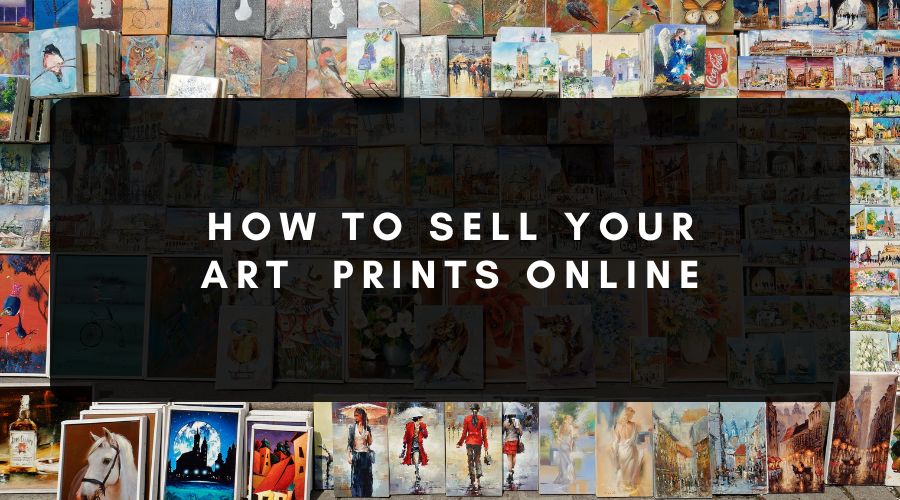
Guide to Selling Prints of Your Art Online
You’ve perfected your style and you’re ready to monetise your hard work, but do you know how to sell prints of your art online? Selling art prints online has become a viable and accessible way for artists to reach a wider audience and generate extra income.
Selling digital prints allows you to sell multiple versions of one original piece. It is also a great way to increase your exposure and maximise profits.
How to Sell Prints of Your Artwork
Selling art prints online is a great way to reach a broader audience and allows consumers around the world to access your art. It can also be a profitable way to boost your bottom line and support your artistic endeavours. Digital art is becoming more popular among consumers and an interesting art medium among collectors. Indeed, a digital piece of art was sold for an incredible 69 million dollars in 2021.
Turning your masterpiece into a digital print is a fairly easy process, but ensure you don’t cut corners on the quality of the final piece.
1. Digitise Your Artwork
The first step towards selling art online will be making digital art prints. You can scan or photograph your art to make a digital copy:
Scan Your Art
Scanning your art is the best way to optimise the quality of the digital version in most cases. Use a top-quality scanner to retain the quality of your original artwork. When you’ve scanned your work, make sure it’s not tainted by any marks caused by the scanning process. Pay attention to the paper background too. Use an image resolution of 300 dots per inch (DPI) for high-quality prints.
Photograph Your Art
Photography is the best medium for larger works of art that can’t be scanned or art with shiny elements like metallic pigments or gold leaf. You may wish to get professional help unless you can guarantee the quality of the photo. Use a good camera and a tripod for the best image.
Edit Your Print
Software like Photoshop can help you fine-tune your images. Scanning or photographing your work may lead to colour discrepancies you might want to edit to reflect your original work’s tones. Edit any flaws you see to create the best possible version of your art.
Create a high-resolution image (at least 72 DPI) to retain the best fine art print quality. High resolution will ensure your prints retain their level of detail and clarity and mirror the intricacies of your work.
2. Consider Print on Demand
Owning your own online store doesn’t mean you have to handle every aspect of your business. The easiest option for many artists will be partnering with a print-on-demand supplier. All artists need to do is upload their final digital copy. When a customer purchases the print, the company will print the art, fulfil the order, and ship it to the customer.
When looking for a print-on-demand partner, consider:
- The type of art you want to offer: Are you only selling prints, or have you converted your print into other products? Make sure your print-on-demand company offers all the services you’re looking for.
- Shipping costs: Check national and international delivery rates.
- Fulfilment and shipping time: Prioritise companies that will fulfil orders quickly and guarantee fast delivery.
Select Your Print Materials
Choosing which materials you want to apply your art to is one of the most important decisions in this process. This is because it can determine the quality of your products as well as the items you can sell. If you want to stick to prints, research the different types of fine art paper and choose the options that work best with your art.
Diversify Your Product
Artists who sell artwork online aren’t limited to wall art prints. Try your art on different products like phone cases, t-shirts, or tote bags to see how it translates to different formats and materials.
3. Choose an E-Commerce Platform
Selecting an e-commerce platform to sell your art on is the first step in digitising your business. There are three main options:
E-Commerce Marketplaces
Marketplaces like Etsy, Amazon, or eBay offer easy ways for sellers to connect with customers. Etsy has become a go-to option for creatives who wish to sell their original work. Etsy allows you to create a shop and individual listings. Sellers pay 6.5% transaction fees on every purchase plus a payment processing fee.
E-Commerce Platforms
Platforms like Shopify offer ready-to-launch templates that allow artists with minimal web development knowledge to create their own e-commerce page. You can create your own storefront that reflects your brand identity. E-commerce platforms also offer valuable plugins to help sellers with marketing and operations like payment processing.
Create Your Own Website
If you have the know-how, creating your own website can be an exciting process that gives you creative freedom as you sell art prints. However, setting up a website from scratch can be time-consuming, high-cost, and difficult to maintain without expert knowledge of web development.
Creating an original website will work for some artists. However, using a website builder will be enough for most artists. A low-maintenance website also allows you to focus on what you do best: your art!
4. Set Up Payment Processing
Setting up credit card processing for art work sales is a vital step for any art sales website. Choose a payment processor that understands your sector and knows how to support you as your business grows.
A merchant services provider like Unicorn Group can provide you with an integrated global payment gateway that processes payments in multiple currencies. A merchant account provider also protects your business against fraud and chargebacks and allows you to control all your dealings from a central dashboard.
5. Start Selling Your Art
You’ve got your products, e-commerce shop, set up payment processing, and have your products ready to go. It’s time to hit the ground running!
Build Your Store
As an artist, you understand the importance of aesthetics. Build a stunning website that showcases your art prints in their full glory. Take professional photos of your art and include details about the creative process.
Include information about yourself on your website too. Customers love to know more about a brand and the vision behind it. List your credentials and explain what inspired you to become an artist.
Search Engine Optimisation (SEO)
Implementing SEO best practices throughout your e-commerce shop will help your customers find you. You can achieve this by making it easier for search engines to identify your shop and what you offer. SEO involves adapting your website for Google crawlers and using keywords in all the content on your website. This shows search engines the relevance of each page.
Use keywords based on your brand name, location, products, and the media you use to optimise traffic and make more sales.
Research Pricing Strategies
It’s important to research how to set prices. Consider the time and materials you need to create each piece and be sure to cover the print-on-demand charges too. Set a profit margin and price your prints accordingly.
6. Launch Your Digital Marketing Strategy
The sky’s the limit for your art business if you get your digital marketing strategy right. Think about the following ways to find potential customers and increase your reach:
Social Media Promotion
Use a range of platforms to share different aspects of your business:
- Publish unique content on each platform: Social media users expect different content from each social network. Instagram and Pinterest are the perfect choice for visual art while TikTok and YouTube are best used for tutorials or sharing the creative process.
- Post a variety of content: Post engaging content, from high-quality visuals to time-lapse videos of the creative process. Many people also want to know the person behind a brand. Share your business journey proudly!
- Engagement: Encourage your followers to engage with your posts and Interact with them through comments, live sessions, direct messages, or stitches.
E-Mail Marketing
E-mails are a cost-effective way to keep your customers interested in your brand. However, creating an e-mail marketing campaign takes time and resources. Be patient and build your e-mail list gradually for best results.
- Build your e-mail list: Take every opportunity to collect potential customers’ e-mail addresses. Give them an incentive to subscribe, such as a discount on their first purchase.
- Newsletter: Showcase your prints, share links to your blog, or give insights into the creative process via your newsletter. Attach links to your e-commerce store to direct traffic.
- Promotions: Inform subscribers about any promotions you have and offer exclusive deals or limited edition prints to your loyal customers.
Get Involved in the Art Community
Establish yourself in the art community. You’ll get new contacts, learn from other artists, and show yourself to be a force to be reckoned with as an artist and entrepreneur. These are some ways to get the most out of the art community online:
- Participate in art forums: Engage in communities on Reddit or Facebook. Share your own art, participate in discussions, and be prepared to give advice or feedback to others.
- Host online workshops or webinars: Give tutorials, share the creative process, and establish yourself as a professional online.
Embrace the Limitless Possibilities of an Online Art Store
The power of e-commerce and digital marketing gives artists a limitless opportunity to sell art online and make a name for themselves in the art world. Making a success of your art business will be a question of determination and marketing your brand to reach your target audience.
Continuously create high-quality art, engage with your audience, and explore new marketing channels to ensure the longevity of your online art business. With dedication and passion, you can turn your artistic vision into a thriving enterprise.

